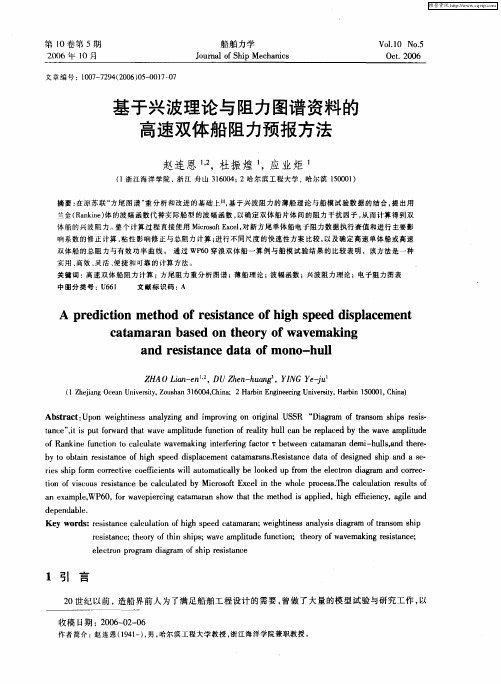基于SHIPFLOW软件的方尾舰船阻力快速预报
- 格式:pdf
- 大小:4.15 MB
- 文档页数:6



本文网址:/cn/article/doi/10.19693/j.issn.1673-3185.03216期刊网址:引用格式:刘经京, 吴海燕, 余龙. 考虑跨洋特征及碎冰对快速性影响的极地探险邮轮型线优化[J]. 中国舰船研究, 2024, 19(2):62–70.LIU J J, WU H Y, YU L. Hull form optimization of polar expedition cruise ship considering transoceanic characteristics and brash ice effect on resistance and propulsion[J]. Chinese Journal of Ship Research, 2024, 19(2): 62–70 (in Chinese).考虑跨洋特征及碎冰对快速性影响的极地探险邮轮型线优化扫码阅读全文刘经京,吴海燕,余龙*上海交通大学 船舶海洋与建筑工程学院,上海 200240摘 要:[目的]全球减碳背景下,为应对极地船舶设计建造的环保要求,需开展跨洋航行时碎冰水域对极地探险邮轮船体型线优化设计的影响规律研究,以获得最佳节能型线。
[方法]针对极地探险邮轮的跨洋航行特征,采用航区权重方法进行量化评估,分析碎冰对阻力和推进效率的影响。
应用计算流体力学耦合离散元法(CFD-DEM )来分析螺旋桨的碎冰水域性能,建立以联合自航功率为目标的优化模型,进而对全船参数化模型开展设计航速下的优化计算。
[结果]计算结果表明,优化后的船型可以满足排水量要求,有效降低了2种水域下的航行功率,其联合自航功率降低了9.71%。
[结论]研究成果验证了基于权重优化方法的可行性和合理性,可为极地探险邮轮的型线和推进器优化设计提供参考。
关键词:极地探险邮轮;型线优化;权重法;计算流体力学耦合离散元法中图分类号: U662.2;U674.81文献标志码: A DOI :10.19693/j.issn.1673-3185.03216Hull form optimization of polar expedition cruise ship considering transoceaniccharacteristics and brash ice effect on resistance and propulsionLIU Jingjing , WU Haiyan , YU Long*School of Naval Architecture, Ocean and Civil Engineering, Shanghai Jiao Tong University,Shanghai 200240, ChinaAbstract : [Objectives ]In the context of global carbon reduction, in order to meet the environmental require-ments of the design and construction of polar ships, this paper studies the impact of brash ice on the optimal design of polar expedition cruise ships when navigating across oceans and designs the most optimal energy-saving hull lines. [Methods ]In view of the transoceanic characteristics of polar expedition cruise ships, the navigation region-based weighting method is used to quantify the evaluation and analyze the impact of brash ice on resistance and propulsion efficiency. An analysis is carried out of the performance of the propeller in broken ice channel through the coupling calculation of the computational fluid dynamics-discrete element method (CFD-DEM), an optimization model with the goal of combined self-propulsion power is established,and optimization calculations are performed for the parametric model of the whole ship at the designed speed.[Results ]The calculation results show that the optimized ship hull meets the requirements of dis-placement and effectively reduces navigation power in open water and broken ice channel with a combined self-propulsion power reduction of 9.71%.[Conclusions ]The results of this study verify the feasibility and rationality of optimization based on the weighting method, and can provide references for the optimization design of hull form and thrusters of polar expedition cruise ships.Key words : polar expedition cruise ship ;optimization design of hull form ;weighting method ;computa-tional fluid dynamics-discrete element method (CFD-DEM)收稿日期: 2022–12–16 修回日期: 2023–04–27 网络首发时间: 2023–06–19 10:57基金项目: 工业和信息化部高技术船舶科研资助项目(MC-201917-C09,MC-201918-C10)作者简介: 刘经京,男,1995年生,博士生。

CFD数值模拟船舶在波浪中的回转操纵运动王建华;万德成【摘要】[目的]船舶回转操纵运动能够反映出船舶的回转特性,与船舶的航行安全密切相关.[方法]为此,采用基于重叠网格技术的CFD求解器naoe-FOAM-SJTU,对标准船模ONRT在波浪中自由回转操纵运动进行直接数值模拟.运用动态重叠网格技术求解船、桨、舵系统复杂运动,计算中,螺旋桨转速对应于静水中的船模自航点进行35°转舵,实现自由回转船舶操纵运动.通过全粘性流场的整体求解,给出波浪中自由回转操纵运动中船舶六自由度运动、螺旋桨和舵的水动力载荷变化,以及波浪中船舶的回转圈特征参数,并与同试验结果进行对比.通过数值计算得到精细的流场信息,分析波浪对船舶自由回转操纵运动的影响.[结果]数值预报得到的船舶运动轨迹、回转圈参数与试验值吻合较好,证明naoe-FOAM-SJTU求解器对于波浪中船—桨—舵相互作用下的船舶自由回转操纵运动数值预报的适用性和可靠性.[结论]船舶回转操纵运动的数值模拟,可为回转性能的评估提供有效的前期评估手段.【期刊名称】《中国舰船研究》【年(卷),期】2019(014)001【总页数】8页(P1-8)【关键词】船舶操纵性;自由回转;船—桨—舵相互作用;naoe-FOAM-SJTU求解器;重叠网格方法【作者】王建华;万德成【作者单位】上海交通大学海洋工程国家重点实验室,上海200240;高新船舶与深海开发装备协同创新中心,上海200240;上海交通大学船舶海洋与建筑工程学院,上海200240;上海交通大学海洋工程国家重点实验室,上海200240;高新船舶与深海开发装备协同创新中心,上海200240;上海交通大学船舶海洋与建筑工程学院,上海200240【正文语种】中文【中图分类】U661.330 引言船舶操纵运动可以反映出船舶在航行过程中的机动性、回转特性和航向的纠偏能力。
操纵性能的优劣与船舶的航行安全和能耗息息相关,其重要性不言而喻。


快速估算航速的方法及软件实现杨博;王德安;冯国垠【摘要】研究一种快速估算航速的方法,并基于该方法开发估算软件NEPTUNE,用于船舶方案设计阶段快速预报航速,提高设计效率.阻力估算采用基于母型船的二因次法,螺旋桨设计采用基于MAU图谱的最佳直径和限制直径螺旋桨设计.通过算例对该方法及软件进行验证,航速误差小于0.2 kn,能够满足方案设计阶段航速估算的要求,具有一定的实用价值.同时,统计了71型船的模型试验数据,回归了相关补贴计算公式,并量化了螺旋桨的转速余量.【期刊名称】《船舶设计通讯》【年(卷),期】2016(000)002【总页数】9页(P1-9)【关键词】航速预报;航速预报软件;阻力系数;粗糙度补贴;螺旋桨设计;航行特性;NEPTUNE【作者】杨博;王德安;冯国垠【作者单位】上海船舶研究设计院,上海201203;上海船舶研究设计院,上海201203;上海船舶研究设计院,上海201203【正文语种】中文【中图分类】U661.1船舶航速预报包括阻力估算和螺旋桨设计2个部分。
常规的阻力估算方法主要有HOLTROP方法[1-2]、艾亚法以及各著名的系列试验方法如陶德系列法、SSPA系列法。
随着时代的发展和优良船型的不断开发,上述方法越来越不能适应市场需要,基于母型船模型试验资料估算船舶阻力越来越多地得到应用[3]。
近20年来,计算流体动力学(CFD)技术迅猛发展,该技术被用来进行船体性能预报、线型优化设计和对船体周围流动现象、机理的研究,取得了众多研究成果并积累了大量经验[4-5],成为船体线型研发的重要手段[6]。
但是,CFD技术仍处在发展阶段,而且运算速度取决于计算机的配置,尚不能满足快速预报的需要。
船舶螺旋桨设计方法主要分为理论法和图谱法[7]。
动量矩理论、升力线法、升力面法[8]、边界元法等均属于理论法。
图谱法因其简单、实用的优势,目前仍被广泛应用。
常用的螺旋桨设计图谱有日本的AU(MAU)系列、瑞典的SSPA 系列以及荷兰的B系列[9]。
基于CFD 的船舶横摇数值模拟与粘性效应分析罗天1,2,3,万德成1,2,31上海交通大学船舶海洋与建筑工程学院,上海2002402上海交通大学海洋工程国家重点实验室,上海2002403高新船舶与深海开发装备协同创新中心,上海200240摘要:[目的]船舶横摇的准确预报对于船舶耐波性、稳性以及操纵性的研究具有十分重要的意义,但船舶横摇运动受流场粘性效应的影响很大,计算中存在较多非线性因素,因而并不适于常用于研究船舶运动的传统势流理论。
为解决这一问题,[方法]采用基于OpenFOAM 软件开发的naoe-FOAM-SJTU 求解器,分别通过欧拉方法和RANS 方法对S60船模典型二维横剖面的强迫横摇进行数值模拟,同时,模拟分析DTMB 5512不同三维船模的自由与强迫横摇运动。
[结果]在成功将横摇阻尼力矩的不同成分分别计算出来后发现,其中漩涡阻尼所占的比例最大,摩擦阻尼所占的比例最小,而舭龙骨在一定的横摇角度范围内则减小了横摇阻尼力矩。
[结论]该结果揭示了横摇参数对船舶横摇运动及横摇阻尼力矩的影响,对准确预报船舶的横摇运动具有重要意义。
关键词:船舶;横摇运动;阻尼系数;阻尼力矩;RANS 方法;欧拉方法中图分类号:U661.3文献标志码:A DOI :10.3969/j.issn.1673-3185.2017.02.001Numerical analysis of viscous effect on ship rolling motions based on CFDLUO Tian 1,2,3,WAN Decheng 1,2,31School of Naval Architecture ,Ocean and Civil Engineering ,Shanghai Jiao Tong University ,Shanghai 200240,China2State Key Laboratory of Ocean Engineering ,Shanghai Jiao Tong University ,Shanghai 200240,China 3Collaborative Innovation Center for Advanced Ship and Deep-Sea Exploration ,Shanghai 200240,ChinaAbstract :During the ship design procedure,the analysis of ship rolling motions is of great significance because the rolling motions have extraordinary effects on the sea-keeping,maneuverability and stability of a ship.It is difficult to simulate rolling motions due to the effect of viscosity,which causes many nonlinear components in computation.As such,the potential theory used for other ship motions cannot be used for rolling motions.This paper simulates the rolling motions of the DTMB 5512ship model and the ship transverse section of the S60ship model with a naoe-FOAM-SJTU solver using the Reynolds Averaged Navier Stokes (RANS )method based on the OpenFOAM.The results of rolling motions are compared with the experimental data,which confirms the reliability of the meshes and results.For the ship transverse section of the S60ship model,the damping coefficient is divided into three parts with the Euler and RANS methods:friction,vorticity and wave parts.For the DTMB 5512ship model,the damping coefficient is also respectively analyzed,including the friction,vorticity,wave and bilge keel parts.The results in this paper show that the vorticity part accounts for the greatest proportion,while the friction part accounts for the least,and the bilge keels reduces the damping moment to a certain extent which shows the effect of rolling parameters on rolling motions and moments.Key words :ship ;rolling motions ;damping coefficient ;damping moment ;RANS method ;Euler method收稿日期:2016-09-01网络出版时间:2017-3-1316:18基金项目:国家自然科学基金资助项目(51379125,51490675,11432009,51579145);长江学者奖励计划(T2014099);上海高校东方学者特聘教授岗位跟踪计划(2013022);工信部数值水池创新专项VIV/VIM 项目(2016-23/09)作者简介:罗天,女,1991年生,硕士生。
基于周期图和神经网络船舶运动预报方法研究的开题报告一、研究背景随着航运业的发展,对于船舶运动预报的需求越来越高。
船舶运动预报是指对船舶在水域中的运动状态进行预测,通常包括航向、航速、位置等信息。
船舶运动预报在船舶交通、海上救援、气象海洋预报等领域都有着广泛的应用。
传统的船舶运动预报方法主要是基于数学模型进行预测。
但由于船舶与海洋环境的复杂交互作用和非线性效应,数学模型预测的准确度不高。
因此,近年来,一些研究者开始探索利用机器学习方法来预测船舶运动状态。
二、研究目的与意义本研究的主要目的是基于周期图和神经网络,建立高准确度的船舶运动预报模型,并探讨预测模型的应用效果和优化方法。
具体目标如下:1. 建立基于周期图和神经网络的船舶运动预报模型,并对模型进行评估和优化。
2. 对比传统的数学模型方法和基于机器学习的船舶运动预报方法,在预测准确度、计算效率等方面进行比较分析。
3. 将预测模型应用于真实的船舶运动预报场景中,并对预测结果进行验证和优化。
本研究的意义在于,提高船舶运动预报的预测准确度和稳定性,为航运业提供更加可靠的服务。
此外,研究中使用的机器学习方法也具有一定的普适性,可以为其他领域的预测任务提供借鉴和启示。
三、研究内容与方法本研究将基于周期图和神经网络,建立船舶运动预报模型。
具体内容和方法如下:1. 数据采集和处理。
通过对历史船舶运动数据的采集和处理,建立可用于训练预测模型的数据集。
2. 周期图分析。
利用周期图方法,对船舶运动状态数据进行分析,并提取周期成分和趋势成分等特征。
3. 神经网络建模。
以提取的周期成分和趋势成分作为输入,建立神经网络模型,进行船舶运动状态的预测。
4. 模型评估和优化。
对建立的预测模型进行评估和优化,提高模型的预测准确度和稳定性。
5. 应用与验证。
将优化后的预测模型应用于真实的船舶运动预报场景中,并对预测结果进行验证和优化。
四、研究计划与进度安排本研究预计历时12个月,具体的计划与进度安排如下:第1-2个月:文献调研和相关技术学习;第3-5个月:数据采集和处理;第6-7个月:周期图分析和预处理;第8-10个月:神经网络建模和优化;第11-12个月:模型应用与验证、论文撰写和答辩。
基于CFD和响应面方法的最小阻力船型自动优化钱建魁;毛筱菲;王孝义;恽秋琴【摘要】计算流体动力学CFD方法凭借其较高的计算精度和获取更多流场信息的能力逐渐成为新船型设计重要手段.文章利用iSight多学科优化平台建立了一套船型优化系统,集成了CFD技术、船型变换及自动生成技术和响应面代理模型技术和组合优化算法.编制了船型参数变换和生成系统实现了船型变换和CFD计算程序Shipflow输入数据的自动连接;通过对主要船型参数的控制,实现整个船型优化流程的自动化.采用了进化遗传算法(GA)与二次序列规划法(SQP)相结合的二阶组合优化方法实现了从全局探索再到局部空间寻优的整个流程.同时,将响应面近似模型(RSM)引入到优化进程中,解决了计算精度与优化效率间的矛盾,使得高精度的CFD 分析工具融入到船舶优化设计进程中成为可能.最后利用该系统对一条设计船的阻力性能进行了优化.%CFD based Ship hydrodynamic Performance analysis, due to its high accuracy, efficiency and more flow information, has become a decisive factor in the development of new ship forms. In this paper, a hull form optimal system is established by means of iSight Multidisciplinary Optimization platform on which the CFD technology,hull transformation and automatic generation,Response surface metamodel tech nology and hybrid optimization algorithm are integrated. The hull form transformation and generation pro gram is developed so that hull form transformation is automatically connected with CFD commercial code SHIPFLOW computation. Through controlling the principal dimensions and shape parameters, the entire automatic optimization process is implemented. The Genetic Algorithm-Sequential Quadratic Programming combined secondorder hybrid optimization method is applied to implement the process from the global op timization to searching local space optimum solution.Meanwhile, the Response Surface Method is intro duced to the optimization process, which constitutes a balance between the calculation accuracy and op-timization efficiency, and makes it possible for the CFD method being adopted in the process of ship hull optimization. Finally, this optimal system is successfully applied in the resistance optimization of an actual ship and better resistance performance is acquired.【期刊名称】《船舶力学》【年(卷),期】2012(016)001【总页数】8页(P36-43)【关键词】船型优化;船型变换;CFD;响应面方法(RSM);遗传算法【作者】钱建魁;毛筱菲;王孝义;恽秋琴【作者单位】武汉理工大学,武汉430063;武汉理工大学,武汉430063;中海油服股份有限公司,天津300451;中国船舶科学研究中心,江苏无锡214082【正文语种】中文【中图分类】U6621 引言近年来随着电子计算机技术的飞速发展以及数值计算理论的不断成熟,计算流体动力学CFD方法凭借着其较高的计算精确度和相对低廉的费用,且能得到比模型试验更多的流场信息,正逐渐成为重要的船舶水动力性能分析手段。